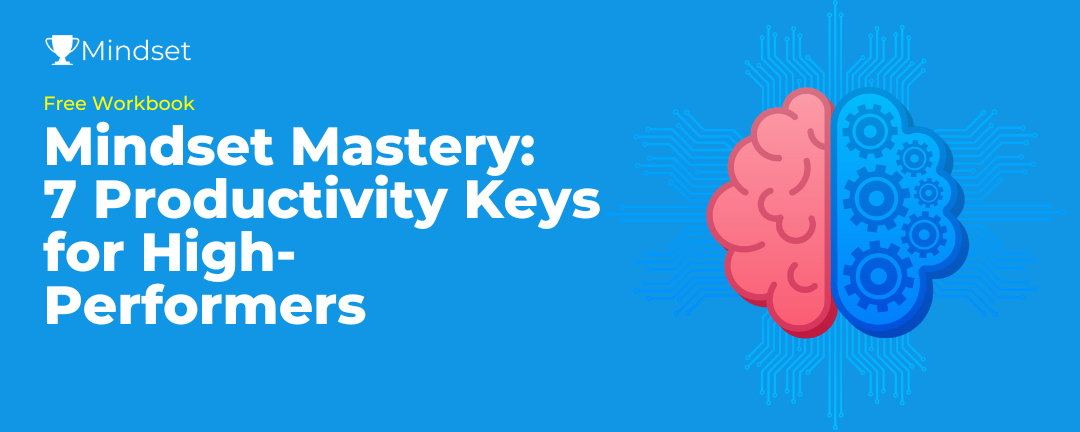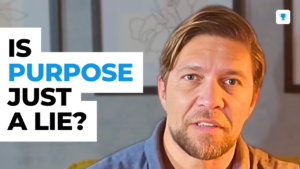
.
✅ FREE WORKBOOK ACCESS: Mindset Mastery: 7 Productivity Keys For High-Performers
Podcast Version
Did you know that some of the world’s greatest breakthroughs began with failures so catastrophic, they almost never happened?
In 1914, Thomas Edison’s factory burned down, destroying years of work. But Instead of giving up, he famously said: “Thank goodness all our mistakes were burned up. Now we can start fresh.”
Weeks later, he was back, inventing again. The light bulb you have in your place is the outcome of that mindset.
In the book The Obstacle is the Way, Ryan Holiday writes about that type of mindset by saying:
“The impediment to action advances action. What stands in the way becomes the way.”
What if the fire in your life, just like in Edison’s factory, is not meant to destroy? What if the flames are asking you a question:
What are you willing to let go of to build something greater?
Let’s uncover the system that transforms struggle into strength—because the flames are already here, and they’re waiting for you to take control.
Struggle as Fire
Why does struggle feel like fire?
Not the good kind, the one that warms or inspires, but the kind that consumes, leaving you scrambling to put out flames you don’t even understand.
Fire can destroy everything in its path, leaving only ashes behind.
But in the right hands? Fire transforms. It melts raw material into something useful, something stronger.
What if the adversity mindset works the same way?
Could it be that feeling burned by struggles isn’t the adversity itself but how we’ve learned to see it?
What if the fire of adversity isn’t here to consume you, but to refine you?
The 3 Layers of Adversity Mastery
If adversity is like fire—a force of transformation waiting for control—how do we move from being burned by it to using it as a forge for something greater?
The answer might be in understanding its layers. Let’s say any problem has 3 layers:
1. Perception
2. Process
3. Projection
Perception: How You See It
Let’s start with perception because everything begins with framing what’s in front of you.
Is adversity something that happens to you—a thief that steals your peace—or is it something that happens for you—a sculptor carving out the person you’re becoming?
Ask yourself:
When you bump into hardship, what’s the lens you use without even thinking?
Do you see it as unfair? As punishment?
Opportunities often come into our lives disguised as pain. That’s why the world has never known a strong person with an easy past.
This is where the seed of mastery is planted: by shifting your perception from reactive to proactive.
That reframes the struggle into an upward spiral.
The more you struggle, the faster you grow. The faster you grow, the less you struggle.
When you see struggle that way, the problem is no longer the problem. The problem becomes how you see the problem.
Process: What You Do With It
But perception is just the beginning. Your problems won’t go away just because you’re seeing adversity differently.
The next critical step is to figure out what you do with that perception.
That is the Process. The second layer of adversity.
Think about the word responsibility. It means response-ability, the ability to choose your response.
This means your behavior should be guided by your decisions, not conditions. Why?
Because you are, by nature, a proactive being.
Proactive beings don’t blame circumstances, conditions, or conditioning for their behavior.
Their actions are driven by their values, not feelings.
So, what do you do with feelings?
You don’t suppress them. You don’t pretend you’re not feeling pain. You welcome pain as a passenger on your journey toward purpose.
When you feel anxious, incapable, and limited, realize that these feelings are signs you’re pushing your boundaries and attempting something meaningful.
Think about it:
Why would you feel anxious or limited if you are just operating inside the boundaries of your comfort zone?
If everything you do is what you already master, there’s no struggle, but also, there’s no progress.
Growing up is not pleasant, it’s painful and necessary.
So, every time you feel limited, incapable, or anxious, take action knowing that:
Pain means that weakness is going away.
Replace “I can’t” with “I’m learning,” days with years, nature with nurture, criticism with critique, and failures with mistakes.
The game of champions is not winning. The game of champions is progress.
And if you think you are overwhelmed and lacking the motivations to fight for your progress, ask yourself this question:
If you lose. Who loses with you?
The worst situations require your best and the lack of your best hurts everything and everyone, not just you.
Projection: How It Shapes Your Future
And then, there’s projection. The third layer of adversity. Projection is the echo that problems leave behind.
It’s that feeling that something has changed in you as a consequence of the struggle you faced.
Every challenge, every setback, every heartbreak carries the potential to shape your future self.
What future self? Look, dreams make demands.
When you have a dream, you create a future and ideal version of yourself in your mind.
That ideal version of yourself looks back at you from that future and judges you with the eyes of Medusa.
It can petrify you in anxiety if you don’t feel you’re acting in a way that will make that ideal future version of yourself exist.
That’s why turning setbacks into motion is the way out of anxiety. Not retreat.
When you move, even when struggling, you satisfy the ideal you created for the future in the present, and you are pulled out of anxiety.
Turning Struggles into Systems
So, you started to understand the layers of adversity—Perception, Process, and Projection. Now, we’re going to use them as the blueprint to build a system.
Why a system?
Because blueprints only tell you what to do, they give you clarity. They don’t tell you how to do it. That, only a system can provide.
To walk through the fires of struggle you need an Adversity System.
This is the step where we go from understanding to knowing because you don’t know the things you don’t do, you only understand them.
So let’s take Perception, Process, and Projection as the blueprint for facing adversity and building your Adversity System.
Here’s how:
Step 1: Codify Your Perception
The first step is to codify your perception.
So, here’s your first task to build your Adversity System.
Answer this question:
What’s the one thing I can ask myself the moment adversity strikes?
What could you say to yourself that would snap you out of that spiral and back into focus?
Maybe it’s something simple, like:
What’s one thing I can learn from this?
Or maybe:
How can this make me better?
This will be your go-to question. Keep it short, something you can remember.
Use your go-to question in the recent setback you wrote about.
The goal here is not to ignore the pain or pretend things are fine—it’s to find that first foothold of clarity.
The go-to question is like lighting a match in the dark. It’s small, but it changes everything.
Step 2: Define Your Process
The second step to building your Adversity System is to define your process.
Most of us have a default reaction when feeling overwhelmed by struggle or feeling in danger.
That default reaction is outlined by John Assaraf in the book Innercise as the 4Fs: Fight, Flight, Freeze, Faint.
But the key to mastery is creating a new default—one that moves you forward, even just an inch.
When you feel overwhelmed, take 6 deep breaths in through your nose and out through your mouth.
This will break the limbic system circuitry that’s signaling your amygdala to use one of the 4Fs as a quick response to danger.
Breathing activates the neocortex, the thinking brain, replacing the quick-fire limbic response with deliberate thought.
So, here’s your second task to build your Adversity System.
After taking 6 deep breaths during an overwhelming situation, ask yourself:
What’s the smallest action possible I can take right now?
The goal here is not to solve the problem. It’s to find the weakest spot you can attack.
The point is to create momentum. Even the smallest action keeps you moving.
And motion, even tiny motion, is what turns chaos into progress.
Step 3: Plan for Projection
Now, the third step to building your Adversity System is Projection.
How do you make sure the effort you put into this challenge doesn’t disappear?
How do you make sure every struggle leaves you stronger for the next one?
This is your third task to build your Adversity System.
Let’s say you just came out of a difficult situation. The dust has settled, and you’re ready to move on.
But before you do, take a moment to ask yourself:
What skill did this struggle give me?
Maybe you learned how to set boundaries. Maybe you discovered you’re more resourceful than you thought you were.
Whatever it is, keep it with you. This is your takeaway, your oxygen for the next wildfire.
And here’s a simple way to measure how projection is helping you grow up through adversity:
Let’s say a child comes to you with a childish problem. You solve it in seconds, right? Why? Because that is not a problem for you.
If it was up to you, the problem wouldn’t exist at all.
After the child goes away happy with your solution, you might even laugh about how silly that was.
So, think with me:
If a problem adds frustration to you, it’s because you are below it. You haven’t grown enough yet to tackle it. Like the child.
But, if you can add humor to a problem it’s because you’re above it. You have grown enough to not only overcome it but also make fun of it.
Make growing up the takeaway, the projection of every struggle.
Because by doing so that might become the last time you had to face that struggle.
The next time, you will just laugh about it.
So here’s how your Adversity System looks:
Perception:
What’s your go-to question for reframing challenges? Write it down and keep it handy.
Process:
What’s the smallest action you can take every time adversity strikes? Practice that until it feels natural.
Projection:
After the challenge, what’s the one skill you will carry forward?
Make it a habit to document your lessons.
And look, this is not gonna be a perfect system overnight.
Like everything else that matters in life, this will start small.
You have to practice it, you have to refine it as you go.
But over time, the Adversity System will become your default system. Part of your standard response.
And that’s when you will walk through fire like there was nothing there that could burn you because actually, there won’t be.




